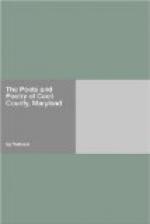The Brown family are of Scotch-Irish extraction, and trace their lineage away back through a long line of ancestors to the time when the name was spelled Brawn, because of the great muscular development of the rugged old Scotch Highlander who founded it.
William Brown’s early education was obtained at the common schools of the neighborhood where he was born. He was endowed by nature with a logical mind, a vivid imagination and great practical common sense; and a memory so tenacious as to enable him to repeat a sermon almost, if not quite, verbatim, a year after he had heard it delivered. Early in life he became an exemplary member of the Methodist Church, and was ordained as a Local Preacher in the Methodist Protestant persuasion, by the Rev. John G. Wilson, very early in the history of that denomination, in the old Harmony Church, not far south of Rowlandville. Subsequently he was admitted to the Conference as a traveling minister and sent to southeastern Pennsylvania, where he continued to preach the gospel with much success until his death, which occurred when his daughter Emma was a child about eight years of age.
Emma’s education began on her father’s knee, when she was little if any more than three years old. Before she was four years old she could repeat Anacreon’s Ode to a Grasshopper, which her father had learned from a quaint old volume of heathen mythology, and taught his little daughter to repeat, by reciting it aloud to her, as she sat upon his knee. Subsequently, and before she had learned to read, he taught her in the same manner “Byron’s Apostrophe to the Ocean,” Campbell’s “Battle of Hohenlinden,” and Byron’s “Destruction of Sennacherib,” all of which seem to have made a deep impression upon her infantile mind, particularly the latter, in speaking of which she characterizes it as “a poem whose barbaric glitter and splendor captivated my imagination even at that early period, and fired my fancy with wild visions of Oriental magnificence and sublimity, so that I believe all my after life caught color and warmth and form from those early impressions of the gorgeous word-painting of the East.” Emma’s subsequent education was limited to a few weeks’ attendance at a young ladies’ seminary at West Chester, Pennsylvania, and a like experience of a few weeks in Wilmington, Delaware, when she was about sixteen years old. But her mind was so full of poesy that there was no room in it for ordinary matters and things, and the duties of a student soon became so irksome that she left both the institutions in disgust. Of her it may be truly said, “she lisp’d in numbers, for the numbers came,” for she composed verses at four years of age, and published poems at ten. Her first effusions appeared in a local paper at Reading, Pa. Being a born poetess, her success as a writer was assured from the first, and her warmth of expression and richness of imagery, combined with a curious quaintness, the outgrowth of the deep vein of mysticism that pervades




